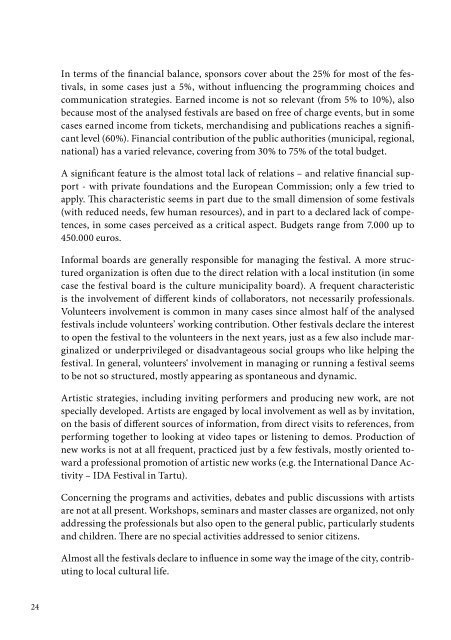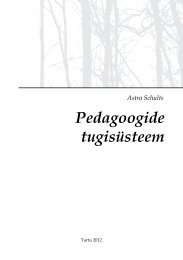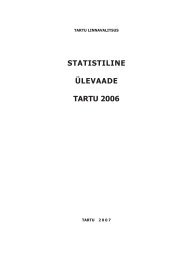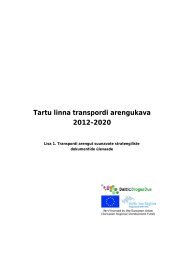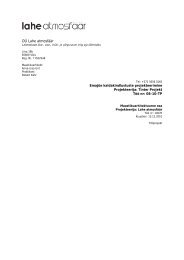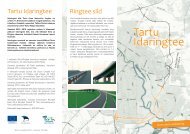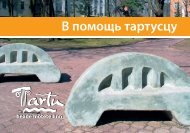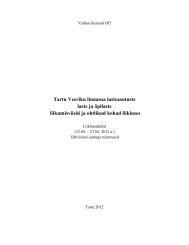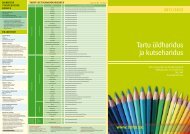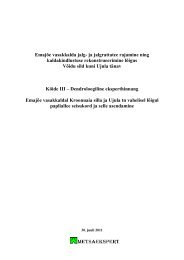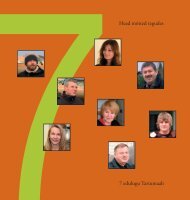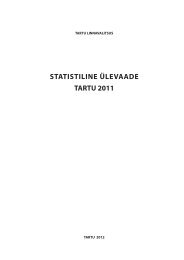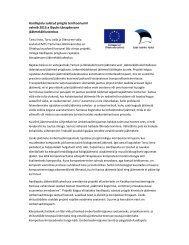Festivals - Tartu
Festivals - Tartu
Festivals - Tartu
You also want an ePaper? Increase the reach of your titles
YUMPU automatically turns print PDFs into web optimized ePapers that Google loves.
In terms of the financial balance, sponsors cover about the 25% for most of the festivals,<br />
in some cases just a 5%, without influencing the programming choices and<br />
communication strategies. Earned income is not so relevant (from 5% to 10%), also<br />
because most of the analysed festivals are based on free of charge events, but in some<br />
cases earned income from tickets, merchandising and publications reaches a significant<br />
level (60%). Financial contribution of the public authorities (municipal, regional,<br />
national) has a varied relevance, covering from 30% to 75% of the total budget.<br />
A significant feature is the almost total lack of relations – and relative financial support<br />
- with private foundations and the European Commission; only a few tried to<br />
apply. This characteristic seems in part due to the small dimension of some festivals<br />
(with reduced needs, few human resources), and in part to a declared lack of competences,<br />
in some cases perceived as a critical aspect. Budgets range from 7.000 up to<br />
450.000 euros.<br />
Informal boards are generally responsible for managing the festival. A more structured<br />
organization is often due to the direct relation with a local institution (in some<br />
case the festival board is the culture municipality board). A frequent characteristic<br />
is the involvement of different kinds of collaborators, not necessarily professionals.<br />
Volunteers involvement is common in many cases since almost half of the analysed<br />
festivals include volunteers’ working contribution. Other festivals declare the interest<br />
to open the festival to the volunteers in the next years, just as a few also include marginalized<br />
or underprivileged or disadvantageous social groups who like helping the<br />
festival. In general, volunteers‘ involvement in managing or running a festival seems<br />
to be not so structured, mostly appearing as spontaneous and dynamic.<br />
Artistic strategies, including inviting performers and producing new work, are not<br />
specially developed. Artists are engaged by local involvement as well as by invitation,<br />
on the basis of different sources of information, from direct visits to references, from<br />
performing together to looking at video tapes or listening to demos. Production of<br />
new works is not at all frequent, practiced just by a few festivals, mostly oriented toward<br />
a professional promotion of artistic new works (e.g. the International Dance Activity<br />
– IDA Festival in <strong>Tartu</strong>).<br />
Concerning the programs and activities, debates and public discussions with artists<br />
are not at all present. Workshops, seminars and master classes are organized, not only<br />
addressing the professionals but also open to the general public, particularly students<br />
and children. There are no special activities addressed to senior citizens.<br />
Almost all the festivals declare to influence in some way the image of the city, contributing<br />
to local cultural life.<br />
24


